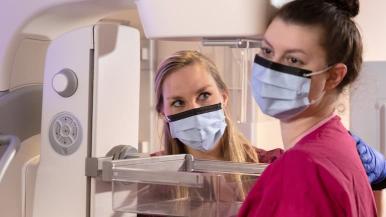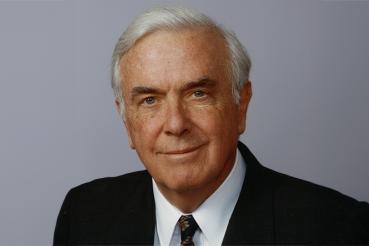If you’re approaching or older than 40, it’s likely that getting an annual mammogram to screen for breast cancer is on your radar. You know screening is important because you’ve heard the stats: One in eight women will be diagnosed with breast cancer in their lifetime; it’s the most common cancer in women; and 230,000 new breast cancers are diagnosed every year.
But with so much information out there, and many differing opinions, breast cancer screening can also bring up a lot of questions.
We asked breast cancer and mammography specialists at RUSH MD Anderson to explain the options — including what to do if you have dense breasts — so you can take charge of your breast health.
Mammograms: The gold standard
“Mammography is the gold standard for detecting small, early-stage breast cancers,” says Lisa Stempel, MD, a diagnostic radiologist at RUSH MD Anderson. “There have been innumerable scientific studies that confirm the benefits of mammograms. No medical test has been as studied as often and as thoroughly as mammography.”
Mammography has helped reduce breast cancer deaths in the United States by nearly 40% since the implementation of routine screening mammography in the early 1990s. Mammograms can show abnormalities in your breasts up to two years before you or your doctor can feel them in a self-exam or a physical breast exam.
The problem with dense breasts
While mammography has certainly played a leading role in decreasing breast cancer mortality by finding breast cancers earlier when they are more curable, it does have some limitations.
One persistent challenge has been using mammography to detect breast cancer in dense breast tissue. Dense breast tissue is particularly challenging because it appears white on screening mammograms — and cancer also appears white on mammograms. (In contrast, fatty tissue appears dark on mammograms, meaning that cancer is easier to see on the images.)
“That means small cancers can hide in dense tissue,” says Paula Grabler, MD, a diagnostic radiologist at RUSH MD Anderson. “In fact, up to one-third of all breast cancers are not visible in dense breasts with standard mammography.”
“Women who have dense breasts are also at higher risk for developing breast cancer,” adds Stempel.
Dense breast tissue is very common. Specifically, 40% of women have dense breasts — and many don’t know they do. That’s often because dense breasts don’t look or feel different; the only way to know you have dense breasts is to have a screening mammogram.
To help women with dense breasts become more aware of the risks of dense breasts and the options available to them, the state of Illinois passed a law on Jan. 1, 2019, that requires doctors to notify women if they have dense breasts and explain their options for additional screening.
Small cancers can hide in dense breast tissue. In fact, up to one-third of all breast cancers are not visible in dense breasts with standard mammography.
Advanced screening for dense breasts
In recent years, advanced screening technologies have emerged that make it easier to detect breast cancer in dense breast tissue.
For instance, 3D digital mammography (also called tomosynthesis or tomo) helps detect additional cancers compared to 2D mammography. “Tomo helps us differentiate between overlapping normal tissue and true masses or distortions in the breast,” Grabler says. “It helps us find those little cancers hidden by dense tissue.”
Stempel also notes that doing supplemental ultrasound screening is important for women with dense breasts.
“We use automated breast ultrasound (ABUS), which gives us a three-dimensional reconstructed image of the entire breast, allowing us to see through dense tissue using sound waves,” she says. “When we add ultrasound in addition to mammography, we significantly increase the ability to find small, invasive breast cancers — which is how we can help women the most. The earlier we find the invasive cancers, the better prognosis women have for curing these cancers.”
Together, 3D mammography and ABUS find significantly smaller invasive cancers compared to screening with 2D digital mammography alone. On average, ABUS detects an additional three to four cancers per 1,000 women. And, RUSH MD Anderson’s breast imaging team has found, on average, an additional five cancers per 1,000 women.
“To help put this in perspective, we typically find approximately five cancers per 1,000 women with digital mammography. But when we add ABUS, that number doubles,” Stempel says. “By adding supplemental ABUS screening, we’re finding more cancers — and we’re finding them small and in early stages.”
Comprehensive screening for high-risk women
RUSH MD Anderson also offers breast MRI, which is even more sensitive than ABUS at detecting small breast cancers. MRI is the most sensitive exam available for detecting breast cancer. The downside to MRI is that it is a more involved test that takes about 30 to 40 minutes and requires the injection of intravenous (IV) contrast. However, RUSH MD Anderson recently began offering fast MRI, which cuts down the amount of time for the test to about 10-15 minutes.
Annual breast screening with an MRI is typically reserved for women who have a greater than 20% lifetime risk of developing breast cancer and women with BRCA mutations, who have a very high risk of developing breast cancer in their lifetime.
When to start breast cancer screening
The question of when you should start getting screened for breast cancer can be complicated. The most agreed-upon recommendation is for women to start getting annual mammograms when they turn 40, even if they have no symptoms or family history of breast cancer.
“Seventy-five percent of breast cancer occurs in women with absolutely no risk factors, and the incidence of breast cancer starts to significantly increase at age 40,” Stempel says. “One out of every six breast cancers are diagnosed in women who are 40 to 50 years old — that’s a lot of breast cancers. And if we want to detect cancer when it is most curable, we have to detect it when it is small and before it has had a chance to spread in the body.”
Breast cancer among women in their 40s also tends to be more aggressive and faster-growing than in older women. This makes getting a screening mammogram every year even more important in this age group.
Stempel notes that early detection also affects women’s treatment options if they do have breast cancer. “That is a very important factor that the task force’s recommendations do not take into account,” she says. “If we can detect cancer early, women may be able to be treated with a lumpectomy rather than a mastectomy; they may just need a small surgery to remove the cancer, allowing them to avoid chemotherapy and sometimes radiation therapy.
“Additionally, we can detect high-risk lesions earlier and remove them before they become cancer. Once we know that a woman is high risk, we can get her on a chemoprevention therapy to decrease her risk for developing breast cancer. These are all incredibly important things for women to consider.”
Lifelong screening
Stempel recommends that women continue annual mammography throughout their lives, as long as screening is not burdensome due to other health issues. Limiting screenings to every other year puts older women at risk for more advanced, and harder-to-treat, breast cancers.
“There is no upper age limit at which mammographic screening is no longer beneficial,” Stempel says. “If you are in relatively good health with five years of life expectancy, you should continue getting your annual screening mammogram. We see active and healthy 90-year-old women for screening mammography.”




